|
The Bamboo Festival is an annual festivity in Gangshan District. With a history of over 200 years, it has been combined with Gangshan lamb cuisine to become an expanded cultural festival. In order to allow the public to appreciate the origin of the Bamboo Festival, we would like to express our gratitude to Ms. Lin Siao-yan for compiling the historical data used by the district office.
Please click on the link for the latest event information:
http://www.gsto.gov.tw/main.php?mode=public&act=i01&public_id=2105
|
|
One: History
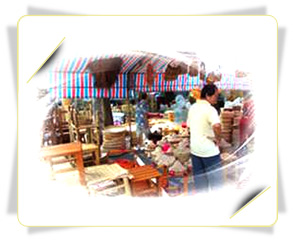 Hometown culture refers to all the living activities that take place in an ethnic group in Taiwan, as well as all the derived expression methods of aesthetics. Our living and social progress is enriched with boundless experiences. Therefore, from such rich emotions and imageries, one may become completely immersed in art and in turn exude artistic qualities. In the era of competitive global cultural industry, hometown culture is still a vital competitive advantage, it is not a marginalized or silent culture. Hometown culture refers to all the living activities that take place in an ethnic group in Taiwan, as well as all the derived expression methods of aesthetics. Our living and social progress is enriched with boundless experiences. Therefore, from such rich emotions and imageries, one may become completely immersed in art and in turn exude artistic qualities. In the era of competitive global cultural industry, hometown culture is still a vital competitive advantage, it is not a marginalized or silent culture.
In remembering the past and encouraging the future, we must continue the heritage and open up the future by building upon the existing foundation, so that the future generations will be left with invaluable cultural heritage that is also endowed with profound meaning. |
|
| When a new trend of searching for local culture is emerging throughout Taiwan, the people of Gangshan have always persisted in organizing the Bamboo Festival, which has over two centuries of history. This serves as a testament to the Gangshan people’s passion for their hometown, because they have not forgotten the cultural asset left behind by their ancestors and instead have materialized it in their lives. Currently, the reasons why the Gangshan Bamboo Festival is the only traditional folk fair with rich hometown characteristics left, the current positioning and heritage of the Bamboo Festival or what kind of cultural asset we will leave behind for our children is something that warrants our attention. |
| |
Tw The historic origin of Bamboo Festival
 This is an extension of the traditional fair. The Holo people called similar events markets, cattle fairs or bamboo festivals. The cattle fair or the bamboo festival mainly involved cattle or bamboo baskets. The only bamboo festival remaining in Taiwan is in Gangshan District, which is still one of the most important activities in the lives of the people staying in the countryside. This is an extension of the traditional fair. The Holo people called similar events markets, cattle fairs or bamboo festivals. The cattle fair or the bamboo festival mainly involved cattle or bamboo baskets. The only bamboo festival remaining in Taiwan is in Gangshan District, which is still one of the most important activities in the lives of the people staying in the countryside.
A fair is referred to as the Bamboo Festival in Gangshan, because it traded mainly agricultural tools such bamboo crafts such as bamboo chairs, ladders, cages, baskets, carrying pole, dustpan. Through changes in time, although the name has not changed, the traded articles have become rather different.
|
|
| |
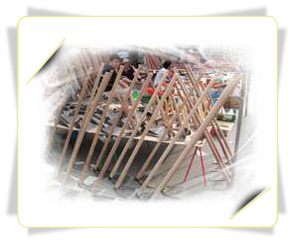 |
Today's Bamboo Festival features a wide variety of general goods similar to that of night markets, but the original characteristics have almost completely disappeared. However, if you look closely, you will still be able to discover a few stalls that are selling old style products such as bamboo products, ox plows, fishing nets, herbal medicines, etc. Although there may not be many customers and the trade volume is low, local residents still actively partake in the annual fair because they are people who intend to carry on the ancient traditions. How much profit can be made is of secondary importance; they simply sell as much as they can!
|
|
Gangshan’s Bamboo Festival is over 200-years-old. The event is held three times a year and each has its unique significance. They are held on March 23 (Mazu’s birthday), August 14 (Eve of Mid-Autumn’s Day) and September 15 (Birthday of the Lord of Righteous) of the Lunar Calendar. During these three grand occasions, not only do the dozen townships/towns in Gangshan District all partake in the event, visitors from as far as Taitung, Pingtung, Tainan, Chiayi and Yunlin also come to join the celebration, therefore the bustling scene is even more exciting than the pilgrimage procession in the countryside.
The location for the Gangshan Bamboo Festival has been changed numerous times. From the old street of Weiren Rd. to Jhongshan Park before relocating to the Jhonghua Rd., it is now held in the newly developed Hehua Rd. In particular, Jhongshan Park was the most memorable. During the Japanese occupation era, the Japanese referred to the current Jhongshan Park as a shrine; after the Japanese, the people of Gangshan continued to hold the Bamboo Festival three times a year.
1. Why does the Bamboo Festival attract such a large crowd?
What makes the Bamboo Festival so attractive to children? Frankly speaking, it is really that big a deal, except that children love to have fun and enjoy some snacks. During the early years, life in the farming community was simple, primitive and poor. What as most lacking was entertainment to escape the monotony of everyday life. Aside from worshipping God, the New Year and festivals, the three fairs held every year provide children with the best venue for entertainment activities. The fairs are such a big deal for children that they look forward to each one of them every year. Not only do children like to participate in the Bamboo Festival, so do adults. Apart from people who genuinely need to purchase furniture, most people go there just to experience the bustling atmosphere, they like to take a leisurely walk around the festival venue to shop and simply to look around. This is especially true for fishermen or farmers in the mountain who seldom go out. Oftentimes they can be seen arriving in bus loads or ox wagons that are filled with gorgeously dressed village women who come here to see the major event. If the village women are out and about, will the men stay at home? Think about it, this event is also like the Chinese Valentine's Day, as countless couples have been matched together at the Bamboo Festival. Every household, whether young or old, goes to the Bamboo Festival. Even the nearby townships such as Mituo, Zihguan, Alian and Yanchao flock here to support the event. Moreover, people even come from as far as Pingtung, Tainan and Chiayi to celebrate. The majority of them come here simply to experience the bustling atmosphere, but there are also people who come here to purchase furniture and clothing. Regardless of their reason for coming, everyone always feel joyful and happy. A touching incident once occurred at the Bamboo Festival and the older generations could never forget such an event. During the Japanese occupation era, a group of aspiring youth was discontent with the brutal suppression by the Japanese and created the Anti-Japanese Organization. Since communications equipment at the time was inadequate and getting in touch was extremely inconvenient, they took advantage of the thrice per annum fair to communicate messages and discuss the location for the next operation. Despite all the volunteers that were sacrificed, they stimulated the martyr spirit r in the hearts of everyone. |
| |
| Speaking of the Bamboo Festival, it is considered the pride of the Gangshan people. The holding of the Bamboo Festival is rather legendary. It is held on March 23 and August 14 of the Lunar Calendar, in resonance with the farmers’ busy season or idle season. The third one is organized on September 15 of the Lunar Calendar in commemoration of the Lord of Righteous, who has a heroically tragic story of guarding the homeland. |
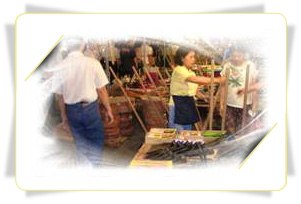 |
|
Origin of the Bamboo Festival’s Lord of Righteous
Roughly 340 years ago, shortly after the demise of the Ming Dynasty, Taiwan was governed by the son of Jheng Cheng-gong, Jheng Jing-suo. At the time, many people in China who were unwilling to be enslaved by the Cing Government fled to Taiwan. In particular, an old man arrived in the town and opened a small store where he sold straw shoes and cold tea for a living. Since his prices were fair and he treated everyone with friendliness, therefore travelers referred to him as Agong (grandpa), and his store was named Agongdian (grandpa’s store), together with the town. Thereafter, since more people arrived in Taiwan from China, Agongdian gradually developed into a small town with two streets. The lower section of the current Weiren Rd. was called Jietou at the time, while the upper section was called Jiewei; there are approximately 800 residents.
Later, Jheng Cheng-gong sent a Cianzong (official name of a military officer, the original name can no longer be ascertained due to a lack of records) to be stationed here. The official building was established on Jiewei (near the Gangshan Elementary School and Weiren Rd.). The Cianzong was in his 50s; he governed people by reasoning and applied an adequate mixture of severity and gentleness. He was friendly to law-abiding citizens but brutal to thieves and robbers and punished them according to the law. Due to his diligence and friendliness towards the citizens, Agongdian became a place where one did not have to shut the doors at night and lost items were never taken; it was like a utopia.
Later, a band of pirates arrived from the Taiwan Strait and harassed the locals in Agongdian by committed all kinds of crimes. Since the Ming Dynasty, pirates had been rampant along the coastal area, and since Agongdian was well administered by the Cianzong, it gradually became a prosperous area and attracted attention from pirates. Cianzong took on the responsibility of defending the land and led the army to battle the pirates. When they returned triumphantly, the captured pirates were beheaded to warn other outlaws. From then onwards, pirates disappeared from the Agongdian region, and the locals lived in peace and enjoyed their work. However, the pirates who escaped capture desperately sought revenge by attempting to assassinate the Cianzong. |
| |
On September 15 of the Luna Calendar, Jheng Jing-jiang dispatched Cianzong’s army to Anping, leaving only a few soldiers guarding Agongdian. When the pirates found out, they led a large number of pirates to lay siege to Agongdian under the cover of dusk. Despite Cianzong’s valiant efforts in leading 200 militia soldiers to defend the hometown, after an entire night of fierce battle, Cianzong was outnumbered and as he had no back up, he was eventually sacrificed.
|
 |
|
| After Cianzong died for his country, Agongdian was no longer immune from pirate attacks and people became apprehensive and could no longer live in peace. At the time, the people who moved to Agongdian remembered the good deeds of the Cianzong and decided to call him grandpa. Since most of the inhabitants who came from China were righteous people who were unwilling to be ruled by the Cing Government, therefore they also called Cianzong Lord of the Righteous to commemorate this heroic and intrepid individual. Every household in Agongdian worshipped him on September 15 of the Lunar Calendar to show their respect. At the time, a group of the local residents wanted to vanquish the pirates but they had no weapons; therefore, they sharpened bamboo sticks and concealed themselves in the forest to ambush the pirates. |
| |
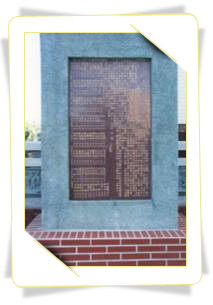 They were ultimately unsuccessful in their attempt. In order to commemorate their heroic efforts, everyone would go to the ancient battle ground (now the Gangshan Jhongshan Park) during the Yimin Festival in honor of the fallen heroes. While grieving, they would cut off bamboo to weave them into books to remember them for eternity. Over a period of time, the event evolved into a bambooware market, or the Bamboo Festival. They were ultimately unsuccessful in their attempt. In order to commemorate their heroic efforts, everyone would go to the ancient battle ground (now the Gangshan Jhongshan Park) during the Yimin Festival in honor of the fallen heroes. While grieving, they would cut off bamboo to weave them into books to remember them for eternity. Over a period of time, the event evolved into a bambooware market, or the Bamboo Festival.
As for the origin of the Yimin Festival, there is also another theory which states that during Year 35 of the Cianlong period (1770), Shanhua’s Huang Jiao, Chen Zong-kuan and Jheng Chun-shih followed the military advisor Jhu Yi (Jhu Yi-de refers to Jhu Yi-guei) and rebelled against the Cing Government in Gangshan; they killed a great deal of flood soldiers in the vicinity. Next year, when the governor Zou Ying-yuan became aware of the information, he led his army, recruited militia and indigenous people to quell the rebels. The rebels were crushed and Huang Jiao fled and disappeared. In memory of those who fought for the hometown, they were referred to as Yimin (righteous people). Regardless of the origin of the Yimin Festival, it was all because of the acts of bravery that these people have demonstrated in protecting their homeland. The Bamboo Festival held during the Yimin Festival is even more meaningful.
|
|
| Nowadays, the joss of the Lord of Righteous is enshrined in the Fude Temple of Shoutian Temple in Gangshan. It is worshipped at the Shoutian Temple on September 15 of the Lunar Calendar every year, where the district supervisor of Gangshan invites representatives from various organizations, as well as chiefs of villages, district administration counselors to attend the ceremony in honor of those who sacrificed themselves for their hometown. |
| |
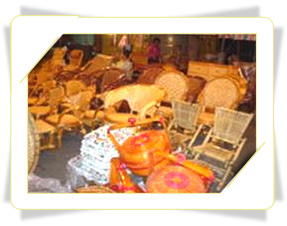 |
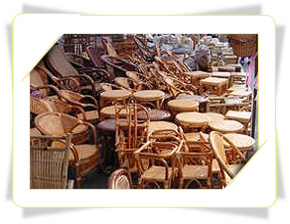 |
Traditional bamboo products at
the Bamboo Festival |
Traditional bamboo products at
the Bamboo Festival |
|
| |
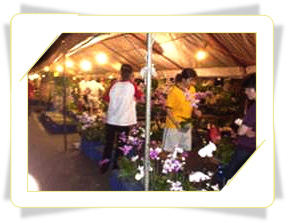 |
 |
| Flower, plants and flora container booth |
Traditional pastry mold (turtle mold) |
|
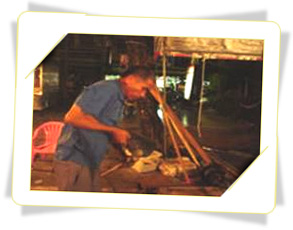 |
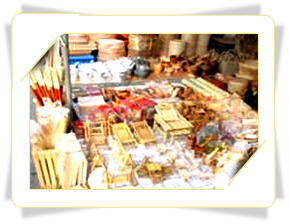 |
Old craftsman demonstrating farm
tool production |
Bamboo products imported from China or
mass produced by machines |
|
| |
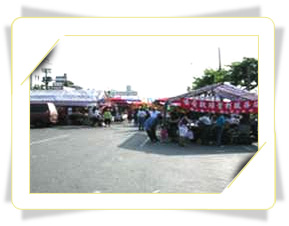 |
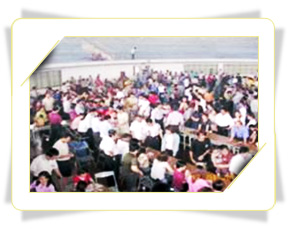 |
Noise pollution control station established by
the vendor’s association under
commission from the Town Office |
Lottery event |
|
|